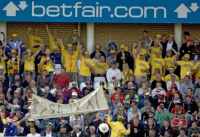Transforming Error into Profit: Profitable Football Trading on Betfair Part 1
This is the first of a series of articles which will discuss strategies for making profit from trading football on Betfair.
There are a number of basic rules to good trading, and one is the ability to admit you were wrong and take action to retrieve the situation.
A case in point came with the Manchester United v. Leeds FA Cup tie on Sunday. I was fairly sure that the reds would come out on top. However, I also had a healthy respect for Leeds, having watched them perform well in a couple of League One games and had particular admiration for Jermaine Beckford, so I also had a back up strategy in mind in case things went wrong.
 The original lay of Leeds for £20 seemed like a good decision on the basis that United were taking the game seriously and had their best team out. In addition, the Reds had never failed to progress from the first stage during 23 years under Sir Alex Ferguson, who was clearly determined to put one over on his old rivals.
The original lay of Leeds for £20 seemed like a good decision on the basis that United were taking the game seriously and had their best team out. In addition, the Reds had never failed to progress from the first stage during 23 years under Sir Alex Ferguson, who was clearly determined to put one over on his old rivals.
Yet from kick-off Leeds played out of their skins and in fact it was not a big shock when Beckford’s deft touch gave them the lead. It probably would have been better to trade out prior to the goal but, as they say, hindsight is a wonderful thing!
You can do one of two things in this situation. You can tell yourself that it is just a blip and that eventually you will be proved correct. Or you can admit to yourself that you probably made an error and that you need to correct the situation. Human nature dictates that the second course of action is much harder.
In this case it was clear to me from the way Leeds were playing that it was worth covering the earlier trade by employing my recovery strategy. I like to use the half-time market in these cases as not long after goal Manchester United were on offer at 5 on Betfair, which given United’s shocked reaction to the goal looked a good call. In addition, Leeds were on offer at just over 2. This was reinforced by the fact that had you not known it, you may have assumed Leeds were the Premiership team and United the improving League One outsiders. Laying United and backing them later at higher odds (which within 15 minutes were nearing 20) was therefore a risk worth taking. Similarly backing Leeds on the half-time market and laying can pay dividends.
Of course this trade can go wrong, especially in cases where the underdog sits back on their lead, but in this case Leeds were still taking the game to United. The other advantage of this method is that it will usually at worse reduce your liability. In this case the worse liability on the draw was £160, but this was only for a period of 10 minutes (due to laying Leeds again later) and this is rather better than £350. A goal to United before half-time might have led to a loss, but aside from one moment from Rooney it never looked likely.
A further advantage of this method is that if it goes well you can use the profit from the half-time market to hedge against the main market (while if it goes wrong you should still be able to recoup some of the loss in the main market due to your hedge).
In this case, with a profit of £160 from the half-time trade, I was able to back Leeds at half-time on the main market with this amount at just over 3, thus all but eliminating the £350 loss and at worst giving me a £140 loss (due to the original £20 lay and therefore still an overall profit of £20)
I fully expected United to get an equaliser, but only later on, so gradually traded out (though I backed Leeds again on different occasions to also reduce the loss on them)
In the end I would have made no loss at all on the main market had United scored a late goal but still made only a small loss on Leeds (£40) giving me £120 profit overall.
The judgement of when to try to cover and when to leave alone (which can be a good strategy in cases where it looks like a blip and that your original judgement was in fact correct) is a tough one – indeed if you ask regulars to my inplay service they will tell that I sometimes decide to stay on my original judgement.
Of course if you make a loss by covering in this way, it means you have made an error twice and therefore probably deserve to lose!
The fact is, no matter how good the tipster, they can and do get their predictions wrong. If they did not, there would be no point in trading. As you know, football often has unpredictable outcomes, so having a get out strategy is always vital.
There is no great secret to this, but it can be hard to remain disciplined enough to put these strategies into effect. As is clear from this article, I am certainly not claiming invincibility and I can and do get things wrong from time to time – but my success rate of around 90 per cent is partly built from having a get out plan.
Please come and have a free trial of my trading service and you will see how it works in practise!
Look out for my next article in this series in which I will discuss the related concept of value betting versus laying the underdog.
Transforming Error into Profit: Profitable Football Trading on Betfair Part 2 - Click Here





